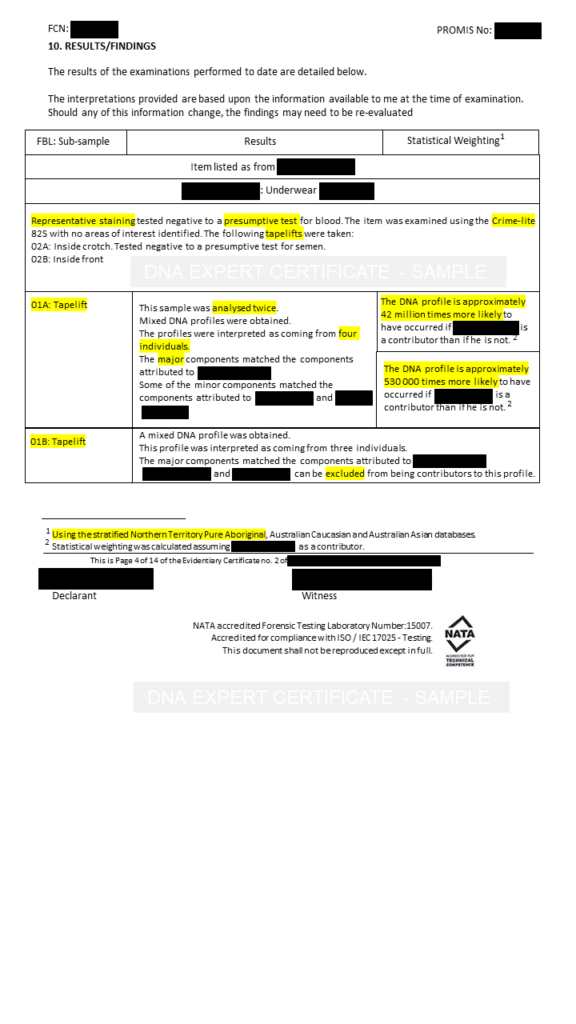
Lawyer interpretation guide
Criminal matters involving DNA can be evidenced by the crown in various ways, depending in part upon the particular state lab, severity of the matter, and the maturity of the matter before the courts.
In Australia, all states and territories will at some stage serve a form of DNA expert certificate concerning indictable matters, with those certificates being referred to as follows;
Victoria Police Forensic Services Department (VPFSD): Statement
NSW Forensic and analytical scientific services (NSWFASS): Expert Certificate
Northern Territory Police, Fire and Emergency Services (NTPFES): DNA Expert Certificate
Forensic Science South Australia (FSSA): Forensic Biology Report
Queensland Health Forensic and Scientific Services (QHFSS): Statement of Witness
Forensic Science Service Tasmania (FSST): Forensic Biology Report
PathWest Forensic Services – Western Australia: Forensic Biology Report
This discussion paper guides the reader through an indictable criminal offence matter in the Northern Territory (anonymised) and sets out some critically relevant aspects within the DNA expert certificate filed by the crown.
The intent is to offer informative assistance to criminal lawyers that may not necessarily be intimately familiar with DNA evidence. Essentially, the information and forensic principles would be consistent throughout Australia, though the formatting and presentation will vary between laboratories. . It is relevant to mention that the forensic and scientific consideration contained herein is not exhaustive.
” DNA expert evidence is relied upon in criminal trials in Australia with greater trust, frequency, and with more force than any other forensic science evidence. Where forensic science evidence is involved, this trust is often misplaced, and factual accuracy suffers.” 1
The unequalled beneficial contribution of DNA to the criminal justice system, has carried unintended side effects. A pervasive perception of infallibility is a noticeable phenomenon over recent years. Koehler (2017) found jurors considered the risk of a false positive error occurring for a range of five identification sciences to be less than one in a million.1
Prosecution version- It was alleged that a sexual assault occurred featuring forced sexual penetration/intercourse. A pair of underpants were said to have been worn by the complainant immediately prior to, and during the alleged incident. The parties were known to each other, and resided in the same dwelling, along with others.
Defence version – It was alleged that the sexual assault did not occur. Particulars regarding the parties residency were not contested.
Forensic evidence- A rape kit examination was not conducted, likely as the complaint was made some weeks post the alleged incident. A pair of the complainant’s underpants were evidenced.
DNA Expert certificate – For brevity below, consideration has been set out regarding the results/findings section of the DNA expert certificate, though there are other areas of relevant consideration. The information given is from an introductory perspective as to some aspects and considerations that we would apply when assessing this piece of evidence. At discussion below, aspects are fleshed out a little, and suggestion is given as to dealing with this evidence further.

Representative staining – The analyst has selected a number of stains to test, which they believe represent the overall staining. This may well mean that not all the visible staining has been tested. Descriptions of the number of stains, their appearance and size are not provided. Photographs, measurements and contemporaneous notes should have been taken. These would normally be provided on request, if they are indeed in existence.
Presumptive test – This chemical screening test is indicative only, and is not confirmatory. Such an indicative test for blood can react with certain substances such as bleach for example. Confirmatory testing is possible for blood and semen.
Crime lite – This is an alternate light source which is calibrated to varying specific wave lengths, which is utilised as a presumptive procedure to indicate biological fluid traces. Different biological fluids require certain waves lengths. Accordingly, the analyst should determine the type of fluid to be detected and stipulate the wavelength applied to the procedure.
Tapelifts – These are manually applied to recover DNA to be sampled.
Tapelift 01A – The presumptive test for semen is not confirmatory. Semen is highly water soluble. The said location of ‘inside crotch’ is imprecise. Photographs with measurements may provide greater clarity. I worked a case where the ‘inside crotch’ was said to be sampled, though inspection of the photographs deduced that it was in fact the outside of the underpants that were sampled.
Tapelift 01B – The underpants are said to have been worn during the alleged incident some two weeks prior to being provided to the police, and apparently located within the subject dwelling during the elapsed period. It is appropriate to consider the possibility that the underpants have been washed since the alleged crime. Contingent on the result of further detailed analysis of the profiles, it may be the case that washing since the event cannot be excluded scientifically. Photographs and contemporaneous examination notes may provide some clarity.
Analysed twice – This would typically indicate a weak profile (i.e. a small amount of DNA). A weak profile is potentially indicative of DNA transfer.
Four individuals – We cannot scientifically state that there are four contributors to a DNA profile. To be precise, this cannot be taken to mean that there are not more contributors. The statistical analysis of the profile requires the analyst to input a number of contributors. This is merely a statement that the analyst has inputted four, and is not intended, nor should it be taken to mean anything more than this.
Major – This individual has contributed significantly more DNA to the sample than the other contributors.
Excluded – The profile was interpreted as coming from three individuals. The accused has been excluded by the analyst as a contributor to the profile.
42 million times more likely – In the verbal scale, this would provide extremely strong support that the accused is a contributor to the profile. It is critical to understand that this in no way is a likelihood that the accused touched or came into contact with the underpants.
530 000 times more likely -In the verbal scale, this would provide very strong support that the accused is a contributor to the profile. Again, it must be made clear, that this is not intended to be a likelihood that the accused deposited his DNA on the underpants, nor should it be taken as such.
Using stratified Northern Territory pure Aboriginal, Australian Caucasian and Australian Asian databases. This means that the analyst has inputted all three databases for the STRmix analysis. A singular database can be selected for the calculations. The decision as to which method is important, as this will generally produce a different numerical qualifier. The appropriate database selection is dependent on the specifics of the matter.
DNA profiles – The DNA samples are analysed using STRmix in order the produce the numerical qualifiers that are shown on the DNA expert certificate. STRmix itself can at times result in false inclusions, and there have been known errors when labs have utilised the software and updates incorrectly. A detailed review of the STRmix output reports should always be conducted to assess whether the crown analysis is robust.
DNA transfer –DNA cells are highly transient, and can transfer from one item to another, and again to another. Various factors are considered when seeking to provide an understanding of this effect upon the specific matter in full context.
Discussion – When viewing this certificate in isolation and from a cursory perspective, there appears to be the potential that the DNA evidence can be accounted for by the prosecution version, and also the defence version. Inculpatory DNA expert evidence is very convincing to jurors. The dangers of not challenging that expert evidence are very real. A recent study3 considered this with quite alarming results. A hypothetical case presented fundamentally flawed forensic evidence to jurors. If the flawed evidence was run with a prosecution expert only, 56% of jurors found guilt.
To consider the matter further, the profiles should be inspected in detail to ensure that they are robust. Following that, and depending on the outcome, consideration may be given to acquiring further evidence from the crown including all photographs, video and contemporaneous notes from the crime scene and laboratory. With all further evidence in hand, consideration will be given to the matter of DNA transfer, as well as laundering. The absence of semen will also be given consideration, as will the ethnicity database selection.
[1] FORENSIC SCIENCE EVIDENCE, WRONGFUL CONVICTIONS AND ADVERSARIAL PROCESS DAVID HAMER*AND GARY EDMOND (university of Queensland Law Journal 2019)
[3} Charlotte Scobie, C. Semmler & M. Proeve (2019) Considering forensic science: individual differences, opposing expert testimony and juror decision making, Psychology, Crime & Law, 25:1, 23-49, DOI: 10.1080/1068316X.2018.148897
